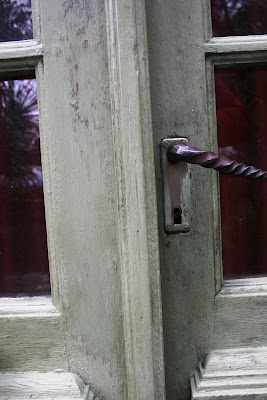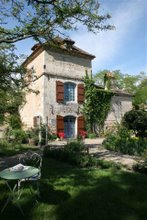Time Warp Portal
Catou and France weave a magic spell over all who enter their treasure house domain, whether they arrive to scout the antiques and brocante at the barn and stable shops or come in friendship to share their convivial hospitality at the oversized kitchen table. Today, a small band of visitors and local residents descended to 'help' in their annual fat duck weekend and I came as part reproter, part culinary spy, eager student and grateful guest.
I reveled in being in company with gastro-friends and these timeless cooks. We were just seven of us, wearing wonderful homemade butchers' aprons to butcher, trim and cook the seven fatted ducks supplied by a neighbor. But I knew I was in the presence of generations of excellence in this kitchen: a butcher father, a frugal grand-mere, a great-grandfather who was a chef in a renowned Paris restaurant. The room was crowded with history and kitchen lore as if these smoky yellow walls who had witnessed centuries of recipes and trucs or tips were inspiring us.
Catou demonstrated her sure hand, warned us not to sacrifice the foie gras, and made the rounds of the table conjoling, correcting and scolding us in turn. We took our work seriously. After all, this would be their food for the year. Instructions were delivered brief, fast and with barely a heartbeat between breaking down the neck, breasts, legs, wings before 'birthing' the ivory firm liver each weighing in just under a pound. Hearts, gesiers or gizzards all got salted and added to the growing pile of meat. The carcasses themselves were quartered as we fought, caressed, and jointed the 15-pound birds with knives, secateurs and bare hands.
Leaving the meat to rest overnight in a cold pantry under a veil of delicate salt and wrapped in a pristine linen sheet, we retired to Greg's own medieval Manoir d'Orr in Lauzerte for a Saturday supper of sweet potato soup, Boeuf Caducienne cooked slowly in Cahor's delicious black wine, a pair of perfect cheeses and a perfect pear almond tart.
Saturday morning we returned to Chateau de Gayrac just as the fat and trimmings from yesterday were put over a very slow flame. From my notes:
11:00- fat trimmings and half glass of water go into a large aluminum caldron over a very low flame protected by a cast iron hob.
11;15- the duck legs are added 4 at a time to the barely melting fat so that they, too, can render their fat to the cauldron. They are placed upside down into the pan so that the fat forms an insulative cushion from the heat.
11;40- all the legs are now in the pan and slowly cooking over the lowest heat...it's not even simmering.
11:45- the manchons or wings are now added.
STIR CONTINUALLY lifting the meat off the bottom so it doesn't stick.
12:00- add gesiers or gizzards
12:15- seven hearts are added
12:30- the fat is only just now starting to simmer
12:45- begin to add the carcasses cut into quarters along with the wing tips
1:00- stir, stir, stir
1:15- begin to remove the legs if done and drain
1:30- continue to cook and stir all pieces until completely cooked.
The confit, once drained, is then placed into aluminum freezer boxes and stored in the freezer. Catou uses a pair fo garden shears or secateurs to snap the knob end of the bone off the leg. This makes it a tidier package not just for storing but for serving as well. The legs are then covered in fat, cooled and then set in the freezer. Freezing the confit in its fat makes a very quick and easy alternative to sterilizing and canning and one that adapts well from this medieval chateau kitchen to your modern apartment.
So what did I learn working with these experts in their own French kitchen?
Seven things I learned to share with you:
- SLOW and even slower then I ever cook, the confit barely simmers for over 2 hours which results in a much more tender confit right away.
- STIR continually not just so the meat or skin doesn't stick to the bottom but to also help regulate the heat so all pieces are cooked evenly.
- CLIP the knob end of the leg bone off with a garden shears before storing.
- SALT the carcasses, too, after cutting into quarters and then confit. Eat the meat off the bone with the help of a little paring knife to scarpe off all the good bits. these flavorful quarters can also be added to soups, bean and lentille vertes.
- COOK the hearts and gesiers together, not forgetting to trim the gesiers of the scaly yellow tough skin on the inside surface.
- SOAK the foie gras in salted cold water to which a couple of tablespoons of vinegar as been added.
- SHARE this knowledge, these trucs, the traditions and table willingly. Preserve the information, make better cooks and educate a hungry audience for your own French Kitchen Table.
and from all of us...
Merci Sept Foie... Catou et France!






















4 comments:
Thank you, thank you, thank you, Kate! May I trouble you for some more details?
There were 7 ducks, right (mention of 7 hearts), just confirming as I imagine the timing may change somewhat for quantities. Roughly, how large each duck?
What are the signs that the duck legs are "done" to remove them out of the cooking pan?
Thank you again for such wonderful sharing!
Sylvie
Les Jardins du Canard qui Rit.
Bon Jour Sylvie! Virgina looks wonderfully like this part of France, especially with seven laughing ducks! Each duck weighs in between 6-7 kilos so yes, preparing fewer ducks will make the chopping etc faster, but the cooking still needs to be bone slow... The leg meat is really done when the flesh pulls away from the bone (see photos on post part 1) and when stabbed with a sharp knife the juices run clear, no pink. The meat should be supple and tender at this point. good luck and let me know how they turn out!
kate
I love duck confit! I have to admit, I've never made it myself but I've always wanted to learn.
When we used to make confit de cannard in the restaurant in Sorges, we didn't stir continuously, only occasionally. The cooking temperature was low enough where I was able to turn the duck pieces with my bare hands, even though the fat was bubbling—about 65 °C. Our cooking took a bit longer than yours.
Also, finished product was packed in leftover (but clean), 5-kilo, plastic tubs and stored at cellar temperature. As long as the meat was completely covered by fat, spoilage was not a problem.
Post a Comment